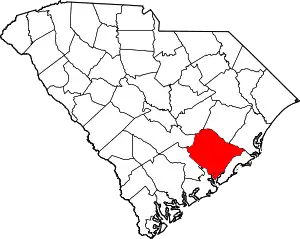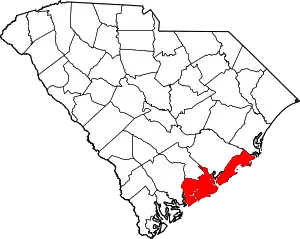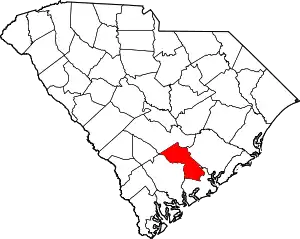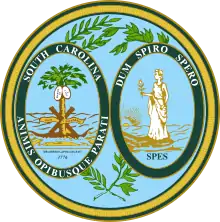Summerville, South Carolina
Summerville is a town in the U.S. state of South Carolina situated mostly in Dorchester County with small portions in Berkeley and Charleston counties. It is part of the Charleston-North Charleston-Summerville Metropolitan Statistical Area. The population of Summerville at the 2010 census was 43,392,[5] and the estimated population was 52,549 as of July 1, 2019.
Summerville, South Carolina | |
|---|---|
 | |
| Motto(s): Sacra Pinus Esto ("The Pine is Sacred") | |
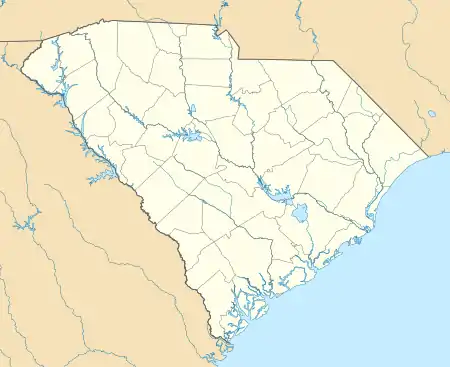 Summerville, South Carolina Location of Summerville, South Carolina  Summerville, South Carolina Summerville, South Carolina (the United States) | |
| Coordinates: 33°0′29″N 80°10′58″W | |
| Country | |
| State | |
| Counties | Dorchester, Berkeley, Charleston |
| Government | |
| • Mayor | River Chavarria |
| Area | |
| • Total | 19.85 sq mi (51.40 km2) |
| • Land | 19.71 sq mi (51.05 km2) |
| • Water | 0.14 sq mi (0.35 km2) |
| Elevation | 89 ft (27 m) |
| Population (2010) | |
| • Total | 43,392 |
| • Estimate (2019)[2] | 52,549 |
| • Density | 2,666.11/sq mi (1,029.40/km2) |
| Time zone | UTC−5 (Eastern (EST)) |
| • Summer (DST) | UTC−4 (EDT) |
| ZIP codes | 29483-29486 |
| Area code(s) | 843, 854 |
| FIPS code | 45-70270[3] |
| GNIS feature ID | 1251073[4] |
| Website | www |
Geography
The center of Summerville is in southeastern Dorchester County; the town extends northeast into Berkeley and Charleston counties. It is bordered to the east by the town of Lincolnville and to the southeast by the city of North Charleston. The Summerville town limits extend south as far as the Ashley River next to Old Fort Dorchester State Historical Park.
U.S. Route 78 passes near the center of Summerville, leading southeast 24 miles (39 km) to downtown Charleston and northwest 29 miles (47 km) to Interstate 95 at St. George. Interstate 26 leads through the northeast corner of Summerville with access from Exit 199, leading southeast to Charleston and northwest 90 miles (140 km) to Columbia.
According to the United States Census Bureau, the town has a total area of 18.1 square miles (47.0 km2), of which 18.0 square miles (46.7 km2) is land and 0.12 square miles (0.3 km2), or 0.62%, is water.[5]
Demographics
| Historical population | |||
|---|---|---|---|
| Census | Pop. | %± | |
| 1880 | 1,371 | — | |
| 1890 | 2,219 | 61.9% | |
| 1900 | 2,420 | 9.1% | |
| 1910 | 2,355 | −2.7% | |
| 1920 | 2,550 | 8.3% | |
| 1930 | 2,579 | 1.1% | |
| 1940 | 3,023 | 17.2% | |
| 1950 | 3,312 | 9.6% | |
| 1960 | 3,633 | 9.7% | |
| 1970 | 3,839 | 5.7% | |
| 1980 | 6,492 | 69.1% | |
| 1990 | 22,519 | 246.9% | |
| 2000 | 27,752 | 23.2% | |
| 2010 | 43,392 | 56.4% | |
| 2019 (est.) | 52,549 | [2] | 21.1% |
| U.S. Decennial Census | |||
As of the census[3] of 2010, there were 43,392 people residing in 16,181 households in the town. The population density of Summerville is 2,404.7 inhabitants per square mile. The racial makeup of the town was 72.1% White, 21.4% Black or African American, 0.4% Native American, 1.5% Asian, 0.1% Pacific Islander, 1.6% from other races, and 2.9% from two or more races. Hispanic or Latino of any race were 5.0% of the population.
There were 16,181 households, out of which 38.6% had children under the age of 18 living with them, 48.9% were married couples living together, 15.4% had a female householder with no husband present, and 31.0% were non-families. 25.3% of all households were made up of individuals, and 8.8% had someone living alone who was 65 years of age or older. The average household size was 2.55.
In the town, 27.0% of the population was under the age of 18, and 10.5% was 65 years of age or older. The median age was 34.7 years.
The median income for a household in the town was $54,677. About 11.2% of the population was below the poverty line. The median value of an owner-occupied home was $182,000.
History

The first settlement in Summerville began following the American Revolutionary War; it was referred to as Pineland Village in 1785. Development in the area resulted from plantation owners who resided in the Charleston area, and who came to Summerville to escape seasonal insects and swamp fever.[6]
Summerville became an official town in 1847. In that year, the town passed a law against cutting down trees of sizes, the first of such laws in the United States, and a $25 fine was issued upon any who did so without permission. Today, the motto upon the town's official seal reads "Sacra Pinus Esto (The Pine is Sacred)." [7]
In 1899, the International Congress of Physicians (or "Tuberculosis Congress"[6]) listed Summerville to be one of the two best areas in the world for treatment and recovery of lung and throat disorders. It received such notation due to its dry and sandy location, and the many pine trees in the area that release turpentine derivatives into the air. This notation is credited with aiding the commercial and residential development of Summerville.[7]
The former Summerville post office built in 1938 contains a mural, Train Time – Summerville, painted by Bernadine Custer in 1939. Federally commissioned murals were produced from 1934 to 1943 in the United States through the Section of Painting and Sculpture, later called the Section of Fine Arts, of the Treasury Department.[8]
The Ashley River Road, Middleton Place, Colonial Dorchester State Historic Site, Old White Meeting House Ruins and Cemetery, and the Summerville Historic District are listed on the National Register of Historic Places.[9]
Arts and culture
Starting in 1972, the town of Summerville has supported the Summerville Family YMCA in hosting the annual Flowertown Festival to support health and wellness programs at the YMCA.[10] It is the largest arts and crafts festival in South Carolina. It is held during the last weekend of March or the first weekend of April in the Summerville Azalea Park. It will often coincide with the Annual Cooper River Bridge Run that is held in Charleston the same weekend. During the three days of the Flowertown Festival, Summerville will see approximately 200,000 visitors. Admission and parking is free to all who attend. There is no alcohol or pets permitted at the festival. Approximately 200 artist from around the country are invited and will have their works on display for purchase. Additionally, area restaurants are featured in the "Taste" section of the festival where tickets can be purchased to sample their offerings. Children can enjoy the carnival in the Children's Jubilee/Kids Fest section of the festival.
In 1925, these flowers led Summerville's Chamber of Commerce to adopt the slogan "Flower Town in the Pines."
Summerville claims the title "The Birthplace of Sweet Tea."[11] However, a recipe for sweet iced tea published in Texas native Marion Cabell's 1879 cookbook, Housekeeping in Old Virginia has been cited as evidence against this claim.[12]
Education
Public education in Summerville is administered by Dorchester School District Two, which operates Summerville High School. 10,000-capacity Memorial Stadium in Summerville is used for the American football matches.
Summerville has a public library, a branch of the Dorchester County Library.[13]
Notable people
- Shanola Hampton, actress, best known for playing the wonderful Veronica Fisher on the television show Shameless.
- Sam Esmail, film and television producer known for Mr. Robot and Homecoming, resident of a few years[14]
- Brett Gardner, baseball player for the New York Yankees
- A. J. Green, 5-time NFL Pro Bowl wide receiver for the Cincinnati Bengals
- Charles Green (1950-2017), known as the Angry Grandpa from YouTube
- Milton Jennings, professional basketball player
- John McKissick (1926-2019), high school football coach, winningest football coach at any level
- Fern Michaels, author
References
- "2019 U.S. Gazetteer Files". United States Census Bureau. Retrieved July 29, 2020.
- "Population and Housing Unit Estimates". United States Census Bureau. May 24, 2020. Retrieved May 27, 2020.
- "U.S. Census website". United States Census Bureau. Retrieved January 31, 2008.
- "US Board on Geographic Names". United States Geological Survey. October 25, 2007. Retrieved January 31, 2008.
- "Geographic Identifiers: 2010 Demographic Profile Data (G001): Summerville town, South Carolina". U.S. Census Bureau, American. Archived from the original on February 12, 2020.
- Historic Facts About Summerville & Dorchester County, archived from the original on July 17, 2011
- Summerville's Book of History, archived from the original on March 25, 2003
- Arnesen, Eric (2007). Encyclopedia of U.S. Labor and Working-Class History. 1. New York: Routledge. ISBN 9780415968263.
- "National Register Information System". National Register of Historic Places. National Park Service. March 13, 2009.
- "Flowertown Festival - Summerville Family YMCA". May 19, 2016.
- "Brief History of Summerville".
- Moss, Robert F. "Summerville can't squeeze the facts out of sweet tea's murky history". Charleston City Paper.
- "South Carolina libraries and archives". SCIWAY. Retrieved June 8, 2019.
- "Sam Esmail, Class of 1995". Classmates. Retrieved November 5, 2019.
External links
- Town of Summerville official website
- Summerville D.R.E.A.M. (Downtown Restoration, Enhancement and Management)
- Summerville & Dorchester County's Official Tourism Site
- Azalea Magazine (Modern Living in the Old South, Summerville's magazine)
- Summerville Family YMCA, Flowertown Festival official website
